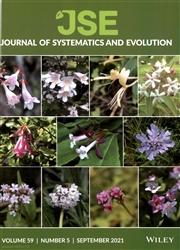中国西南横断山脉高山竹子对高海拔的持续遗传适应性
IF 2.9
1区 生物学
Q1 Agricultural and Biological Sciences
引用次数: 0
摘要
高海拔适应导致表型改变的例子有很多,但导致这些改变的基本过程以及适应过程是否具有连续性仍然难以捉摸,尤其是在植物中。分布在广阔海拔梯度上的高山植物为解决这一问题提供了一个理想的系统。在此,我们分别从高山竹类的法桐属和玉竹属中不同海拔(中国西南横断山脉海拔约 1500 米、约 2500 米和约 3600 米)的三个物种的多个组织中收集了转录组,并进行了进化和表达分析。结果表明,高海拔适应在两个属的进化史中出现较早,并随着海拔的升高而不断演化。此外,在这两个属中观察到了基因变化的趋同性,在正选择下发现了大量负责高海拔适应的候选基因。总之,我们的研究为进一步研究植物的高海拔适应性提供了一个经验范例和宝贵的遗传资源,并为生物多样性热点地区的植物如何适应高海拔环境提供了新的启示。本文章由计算机程序翻译,如有差异,请以英文原文为准。

Continuous genetic adaptation to high elevations of alpine bamboos in the Hengduan Mountains, Southwest China
Many examples of phenotypic modifications resulting from high-elevation adaptation have been documented, however, the underlying processes responsible for these modifications and whether the continuity of the adaptation process remain elusive, particularly in plants. The alpine plants distributed along wide elevational gradients provide an ideal system to address this question. Here, we collected transcriptomes from multiple tissues of three species with different elevations (~1500, ~2500, and ~3600 m in the Hengduan Mountains, Southwest China) in two genera Fargesia and Yushania of alpine bamboos, respectively, and conducted evolutionary and expressional analyses. Results showed that high-elevation adaptation emerged earlier in the evolutionary history of both genera and evolved continuously as the elevation increased. Moreover, convergence of genetic changes was observed in the two genera, with amounts of candidate genes responsible for high-elevation adaptation identified under positive selection. Overall, our study provides an empirical example and valuable genetic resource for further investigation of high-elevation adaptation in plants and sheds new light on how plants adapting to high-elevation environments in a biodiversity hotspot.
求助全文
通过发布文献求助,成功后即可免费获取论文全文。
去求助
来源期刊

Journal of Systematics and Evolution
Agricultural and Biological Sciences-Ecology, Evolution, Behavior and Systematics
CiteScore
7.40
自引率
8.10%
发文量
1368
审稿时长
6-12 weeks
期刊介绍:
Journal of Systematics and Evolution (JSE, since 2008; formerly Acta Phytotaxonomica Sinica) is a plant-based international journal newly dedicated to the description and understanding of the biological diversity. It covers: description of new taxa, monographic revision, phylogenetics, molecular evolution and genome evolution, evolutionary developmental biology, evolutionary ecology, population biology, conservation biology, biogeography, paleobiology, evolutionary theories, and related subjects.
 求助内容:
求助内容: 应助结果提醒方式:
应助结果提醒方式:


